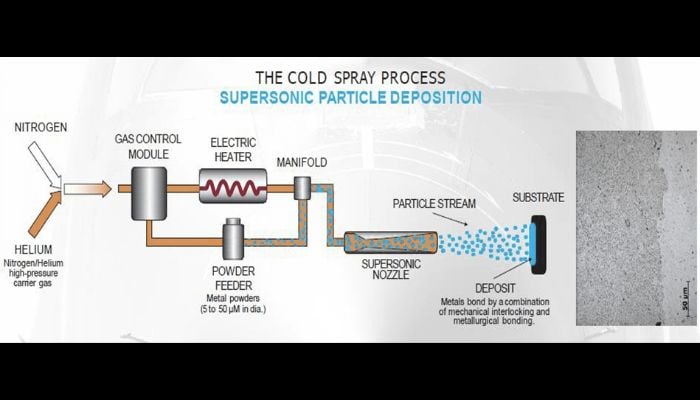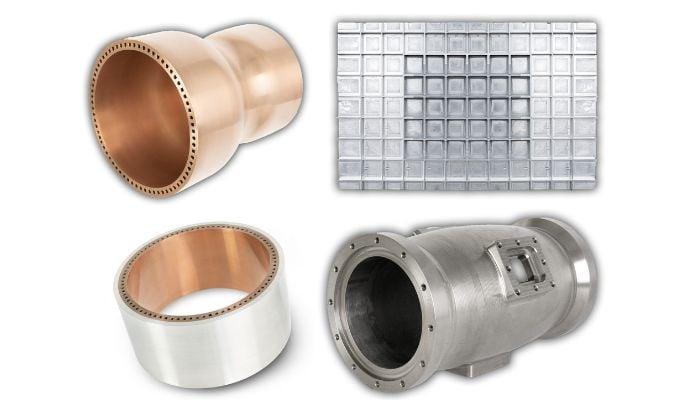All You Need to Know About Cold Spray Additive Manufacturing

The various additive manufacturing technologies available today can seem endless, though they often fall into one of about seven categories, but not all of them. Take, for example, cold spray additive manufacturing. Cold spray is a technique which involves the use of a high-velocity gas jet – at up to four times the speed of sound – which accelerates powder particles onto a substrate, usually a metal, over a distance of approximately 25mm. This technique can form a coating over the piece, or, in the case of AM, can be used to form an entire part. The cold spray process itself was developed by researchers at the Institute of Theoretical and Applied Mechanics (ITAM) of the Siberian Branch of the Russian Academy of Science, in the 1980s. The group realized that it was possible to coat solid particles with a gas flow at room stagnation temperature.
In terms of cold spray additive manufacturing, this is a technique which uses cold spraying to form entire parts (or to fix broken or damaged parts). It is done with a spray nozzle and robotic arms that either are moving a substrate or the nozzle itself, with different benefits and limitations to each method. But what are the advantages of using this method? What about the applications? We took a closer look.

Photo credit: VRC Metal Systems
Benefits and Limitations of Cold Spray Additive Manufacturing
One of the main advantages of cold spray in general over thermal spraying is that, because the temperature does not go above 800 degrees, it can be used for temperature-sensitive materials (including nanostructured) and oxygen sensitive (such as titanium and aluminum, both of which oxidize) as the particles do not melt. Furthermore, the production time is short – shorter than SLM, EBM, and LMD, and the product size list unlimited. Additionally, cold spraying can be undertaken with a number of different metals and their compounds. These include aluminum, nickel, copper, steel and titanium, as well as precious metals – silver, gold, and platinum – and refractory materials. Furthermore, cold spray additive manufacturing has a particular advantage for the repairing of corroded or damaged parts, particularly in the aerospace industry.
That being said, the main limitation of the cold spray technique is the restrictive part geometry, low density and accuracy, and material embrittlement. Compared to other 3D printing methods, the options are extremely limited, with machines offered by only a few manufacturers. The products require milling after being made to smooth the surfaces and sharpen the edges for an optimized shape.

Parts made using cold spray additive manufacturing (Photo credit: Impact Innovations)
Companies and Applications
Firms which offer cold spray additive manufacturing include SpEE3D with their patented ‘Supersonic Particle Deposition’; this is 1000 times faster than traditional metal 3D printing (eg. binder jetting and DMLS), offered by the WarpSPEE3D 3D Metal Printer. According to the firm, their use of the technology makes them the only manufacturer to offer parts at a cost similar to casting, and far cheaper than CNC parts. Another well known manufacturer is Impact Innovations, a German company which focuses on cold spray solutions, selling Cold Spray Systems including the cold spray gun, powder feeder, control panel, water cooling, and powder preheater. VRC Metal Systems has its own selection, with a mobile cold spraying system and several integrated solutions with CNC. Some firms, such as Höganäs of Sweden, focus on powder production for the technology.
And though it may seem niche given the relatively small number of solutions that are out there, it has already been used for some pretty incredible applications. For example, as early as 2009, General Electric received a grant from the German government to fund their research into the enhancement of modern jet engines. Their first use of the grant was to make large turbofan engines (a type of jet engine used in turbo propulsion), resulting in ‘considerable’ cost savings. The technology can also be used to make grid structures which reinforce aerospace components, and for rocket combustion chambers and nozzles. This is the case for SPEE3D which has used their technology for everything from rockets to military applications.
Did you already know about cold spray additive manufacturing? Let us know in a comment below or on our LinkedIn, Facebook, and Twitter pages! Don’t forget to sign up for our free weekly Newsletter here, the latest 3D printing news straight to your inbox! You can also find all our videos on our YouTube channel.






